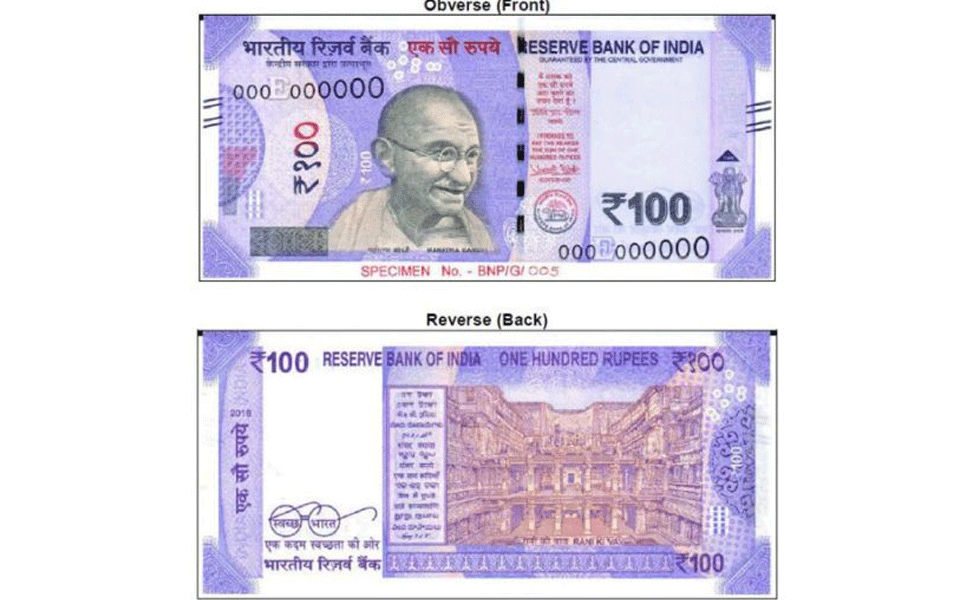NEW DELHI: The Reserve Bank of India (RBI) has given a lavender wash to the new Rs. 100 note which will be in circulation by next month. Two years ago, when Prime Minister Narendra Modi had announced demonetization of Rs. 1,000 and Rs. 500 notes, the powder blue Rs. 100 note was left untouched. It was soon the most sought-after currency note in India till the new Rs. 2,000 and Rs. 500 arrived in the banks.
The new violet note is part of the revised design series introduced after demonetization in November 2016. The latest variant features Gujarat's 'Rani Ki Vav' (queen's stepwell) along with the Swachh Bharat logo and slogan on its reverse. Gandhi ji's placement remains the same.
"The base colour of the note is lavender. The note has other designs, geometric patterns aligning with the overall colour scheme, both at the obverse and reverse. Dimension of the banknote will be 66 mm x 142 mm," the RBI said in a statement.
All the Rs. 100 notes issued by the Reserve Bank in the earlier series will continue to be legal tender, the RBI said.
The new note is slightly smaller than the existing one and bigger than the Rs. 10 note. Once the new notes arrive, the banks may have to again recalibrate the ATMs to accommodate the new notes, after settings had to be changed to dispense new notes of Rs. 2,000, 500 and 200 notes in 2016.
In 2014, UNESCO had recognised Gujarat's 'Rani-ki-Vav', the 11th-century wonder in Patan, as a World Heritage Site. It will make a grand debut on this new Rs. 100 note.
The 200-rupee note with a base colour of bright yellow bears the motif of Sanchi Stupa. The chocolate brown Rs. 10 note has Konark Sun Temple on the reverse side. The fluorescent blue Rs. 50 notes features Stone Chariot in Hampi, another world heritage site recognised by UNESCO.
courtesy : ndtv.com
Let the Truth be known. If you read VB and like VB, please be a VB Supporter and Help us deliver the Truth to one and all.
Jaipur (PTI): Congress leader Ashok Gehlot on Thursday urged the Centre to reconsider its definition of the Aravallis, warning that any damage to the mountain range posed a serious threat to the ecological future of north India.
Gehlot, a former Rajasthan chief minister, changed his social media profile picture in support of the nationwide 'SaveAravalli' campaign amid growing debate over mining and environmental safeguards in the Aravalli Range.
It was his symbolic protest against the new interpretation under which hills lower than 100 metres are no longer being recognised as part of the Aravalli system, he said.
ALSO READ:In open letter, RJD MP appeals to parliamentarians to oppose VB-G RAM G Bill
"The Aravalli cannot be judged by tape measures or height alone. It must be assessed by its ecological importance," Gehlot said, adding that the revised definition raised "a big question" over the future of north India.
Appealing to the Centre and the Supreme Court, Gehlot said the issue must be reconsidered in the interest of future generations and environmental security. He also urged citizens to participate in the campaign by changing their display pictures online to draw attention to the issue.
He said the Aravalli range functioned as a natural green wall against the expansion of the Thar desert and extreme heatwaves, protecting Delhi, Haryana and western Uttar Pradesh. Opening up smaller hills and so-called gap areas for mining would allow desertification to advance rapidly, he warned.
Gehlot also flagged concerns over air pollution, saying the hills and forests of the Aravallis acted as the "lungs" of the National Capital Region by checking dust storms and absorbing pollutants.
"When pollution levels are so alarming even with the Aravalli standing, one can imagine how disastrous the situation will be without it," he said.
Highlighting the water crisis, the former chief minister said the rocky terrain of the Aravallis played a crucial role in groundwater recharge by channelising rainwater underground.
"If the hills are destroyed, drinking water shortages will intensify, wildlife will disappear and the entire ecology will be pushed into danger," he said.
Gehlot argued that, from a scientific perspective, the Aravallis was a continuous chain and that even smaller hillocks were as vital as higher peaks.





